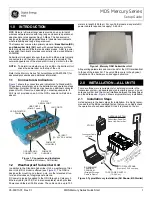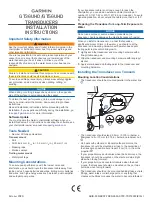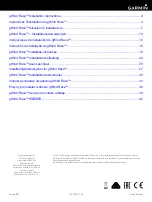
Section IV
Overall System Theory
4.1
Introduction
This section presents the overall principles of operation for the
DX-25U AM TRANSMITTER, including a review of Digital
Modulation, and circuits not described in SECTIONS A through S.
4.2
Block Diagram Description
Refer to Figure 4-1, DX-25U Block Diagram. Most of the blocks
on the diagram represent printed circuit boards in the transmitter.
The Overall Schematic Diagram, 839-7855-151, in the Drawing
Package, includes many of the same blocks identified as printed
circuit boards.
The Block Diagram description is divided into four sections:
a. RF Section
b. Audio and Modulation Section
c. Controller Section
d. Power Supplies
4.2.1
RF Section
The RF Section includes the Oscillator through the Power Am-
plifiers, Bandpass Filter, and Pi Matching Network.
The RF Section generates an RF signal, then amplifies the signal
to a level high enough to drive the Power Amplifier stage. In the
Power Amplifier stage, the RF amplifier outputs are combined,
and fed to a Bandpass Filter/Output Network and then to a 50
Ohm RF output point. The Pi Matching Network allows conven-
ient matching to loads that are not exactly 50 Ohms.
4.2.1.1
Oscillator
The RF signal path begins at the Oscillator from a crystal
oscillator or from an external source, such as an AM Stereo
Exciter or Frequency Synthesizer. The Oscillator output is fed to
the Buffer Amplifier.
4.2.1.2
Buffer Amplifier
The Buffer Amplifier amplifies the Oscillator output and pro-
vides a stable input signal to drive the Predriver stage.
4.2.1.3
Predriver
The Predriver stage uses one of the 79 identical and interchange-
able RF amplifiers used in the DX-25U. The Predriver amplifies
the Buffer Amplifier signal to a high enough level to operate the
14 RF amplifiers used in the Driver stage.
4.2.1.4
Driver Stage
The Driver stage consists of the combined output of up to 14 RF
amplifier modules. One of the RF amplifier modules is utilized
as a spare and two operate in a reserve capacity to compensate
for AC line variations. One of these two Driver Modules operates
as a “coarse” adjustment, “ON” or “OFF,” while the other
provides “fine” adjustment for the Power Amplifier stage drive
level. The Driver Supply Regulator provides a variable DC
supply for this module.
4.2.1.5
Driver Supply Regulator
The Driver Supply Regulator is part of a loop which controls RF
drive level to the power amplifier. An “RF Sense” feedback signal
from the RF splitter controls the regulator output voltage to
control the Driver stage output.
4.2.1.6
Driver Encoder/Temp Sense Board
The Driver Encoder/Temp Sense Board provides the turn-on
signals for the 14 Driver Modules. The “RF Sense” feedback
signal from the RF splitter is also fed to this board for automatic
control of one module. Other circuits on the board monitor heat
sink temperature of PA Modules RF1 and RF2 and air flow from
the four cooling fans.
4.2.1.7
RF Status Indications: RF Sense Data Lines
Three RF status indicators on the transmitter ColorStat™ panel
indicate Oscillator, Buffer Amplifier, or Predriver output. A Fault
in any section will cause that LED indicator on the ColorStat™
panel to turn RED.
The ColorStat™ panel indicators are normally GREEN. Some
indicators will turn AMBER under certain temporary overload
conditions. If a Fault or abnormal condition exists, the indicator
will turn RED.
Additional indicators are located on the RF amplifiers. Each RF
amplifier is fused, and if an amplifier fault causes a fuse to open,
a red LED will illuminate to indicate the location of the open
fuse.
4.2.1.8
Driver Combiner and RF Splitter
The outputs of the 14 RF amplifiers in the Driver stage are
combined by the Driver Combiner and fed to the RF Splitter. The
RF Splitter provides separate RF drive signals to the individual
RF amplifiers in the Power Amplifier.
4.2.1.9
Power Amplifier (64 RF amplifiers)
The Power Amplifier consists of 64 identical RF amplifier mod-
ules. For “Digital Amplitude Modulation,” encoded audio sig-
nals turn on only as many RF amplifiers as required at any instant
to generate the carrier and the modulating signal. The 64 RF
amplifiers are referred to as “Steps.”
The physical location of the RF amplifier modules in the Power
Amplifier stage creates a combination of 58 equal RF voltage
“Big Steps” and 6 fractional RF voltage “Binary Steps”.
4.2.1.10
PA Combiner
The 64 RF amplifier modules plug into three Main Combiner
motherboards and one Binary Combiner motherboard to make
up the PA Combiner. The module outputs are series combined
by a torroidal transformer to develop the total RF voltage. The
RF signal is then fed to the Output Network.
4.2.1.11
Output Network
The Output Network transforms the low impedance of the PA
Combiner output to a 50 Ohms output impedance. The imped-
ance transformation is accomplished in two sections: the Band-
pass Filter stage and the Pi Matching stage.
Rev. AA: 8-9-00
888-2297-002
4-1
WARNING: Disconnect primary power prior to servicing.
Содержание DX 25U
Страница 2: ......
Страница 10: ......
Страница 28: ......
Страница 32: ......
Страница 46: ......
Страница 58: ......
Страница 82: ......
Страница 150: ......
Страница 158: ......
Страница 166: ......
Страница 174: ......
Страница 176: ......
Страница 196: ......
Страница 206: ......
Страница 212: ......
Страница 218: ......
Страница 270: ......
















































